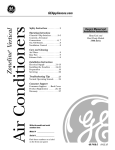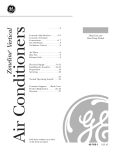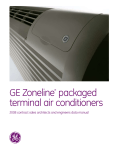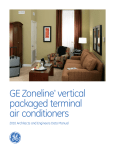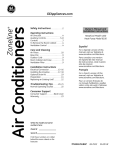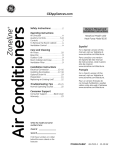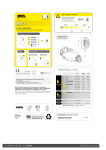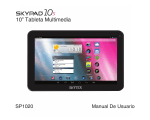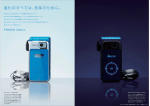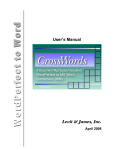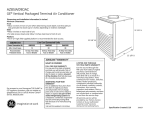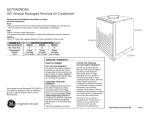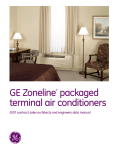Download GE 8500 Series Air Conditioner User Manual
Transcript
GEAppliances.com Air Conditioners Zoneline Vertical ® Safety Instructions . . . . . . . . . . . 2 Operating Instructions Controls—Dip Switches . . . . . . . . . 3–5 Controls—Terminal Connections . . . . . . . . . . . . . . . . . . . 6, 7 On/Off Switch . . . . . . . . . . . . . . . . . . . . 8 Ventilation Control . . . . . . . . . . . . . . . 8 Owner’s Manual and Installation Instructions Cool Only, Heat/Cool and Heat Pump Models 8500 Series Care and Cleaning Air Filters . . . . . . . . . . . . . . . . . . . . . . . . 9 Base Pan . . . . . . . . . . . . . . . . . . . . . . . . 9 Exhaust Coils . . . . . . . . . . . . . . . . . . . . . 9 Installation Instructions Electrical Supply . . . . . . . . . . . . . .11–13 Installing the Zoneline . . . . . . . .14–21 Preparation . . . . . . . . . . . . . . . . . . . . . 10 Servicing . . . . . . . . . . . . . . . . . . . . . . . . 22 Troubleshooting Tips . . . . . . . 23 Normal Operating Sounds . . . . . . . 24 Consumer Support Consumer Support . . . . . . Back Cover Warranty . . . . . . . . . . . . . . . . . . . . . . . 27 Español For a Spanish version of this manual, visit our Website at GEAppliances.com. Para consultar una version en español deeste manual de instrucciones, visite nuestrositio de internet GEAppliances.com. Française For a French version of this manual, visit our Website at GEAppliances.com. Pour une version française de ce manuel d’utilisation, veuillez visiter notre site web à l’adresse GEAppliances.com. Write the model and serial numbers here: Model # ________________________ Serial # _________________________ You can find them on a label on the front case panel. Printed in China TINSEA612JBRZ 49-7639 01-10 GE Safety Instructions IMPORTANT SAFETY INFORMATION. READ ALL INSTRUCTIONS BEFORE USING. WARNING! Risk of electric shock. Can cause injury or death. For your safety, the information in this manual must be followed to minimize the risk of fire, electric shock or personal injury. SAFETY PRECAUTIONS Operating Instructions n This Zoneline must be properly installed in accordance with the Installation Instructions before it is used. See the Installation Instructions in the back of this manual. Care and Cleaning n Replace immediately all electric service cords that have become frayed or otherwise damaged. A damaged power supply cord must be replaced with a new power supply cord obtained from the manufacturer and not repaired. Do not use a cord that shows cracks or abrasion damage along its length or at either the plug or connector end. n Product must be operated with the electrical plug supplied with the product. Do not replace the electrical plug supplied with the product. Troubleshooting Tips n If the receptacle does not match the plug, the receptacle must be changed out by a qualified electrician. n Unplug or disconnect the Zoneline at the fuse box or circuit breaker before making any repairs. NOTE: We strongly recommend that any servicing be performed by a qualified individual. n All air conditioners contain refrigerants, which under federal law must be removed prior to product disposal. If you are getting rid of an old product with refrigerants, check with the company handling disposal about what to do. nThese R410A Air Conditioner Systems require contractors and technicians to use tools, equipment and safety standards approved for use with this refrigerant. DO NOT use equipment certified for R22 refrigerant only. READ AND FOLLOW THIS SAFETY INFORMATION CAREFULLY. Consumer Support SAVE THESE INSTRUCTIONS 2 GEAppliances.com Controls–Dip Switches The dip switch controls are located behind the front case panel, through an opening on the front of the unit. Dip Switches Operating Instructions To access the dip switches, remove the front case panel by removing the filter, taking out the four front screws, the upper two screws from the top of the panel and the shipping screws on each side, if present. (Discard the four side shipping screws, if present). Safety Instructions Controls–dip switches. NOTE: The owner is responsible for setting the appropriate dip switches and connecting terminals. Side shipping screw Side shipping screw Care and Cleaning TL3 (C) (Temp. Limit 3–Cool) TL2 (C) (Temp. Limit 2–Cool) TL1 (C) (Temp. Limit 1–Cool) TL1 (H) (Temp. Limit 1–Heat) TL2 (H) (Temp. Limit 2–Heat) TL3 (H) (Temp. Limit 3–Heat) Troubleshooting Tips ALL I 2R (All Electric Heat) (Heat-pump models only) FREEZ S (Freeze Sentinel) CONST FAN (Constant ON Fan) No Function (Reserved for future use) DUCT (Blower Fan) OCCUPIED (Occupancy Sensor) All Electric Heat (Heat pump models only) When this switch is enabled (UP), heat pump operation is locked out, causing the unit to provide only electric resistance heat. 3 Consumer Support ALL I2R (All Electric Heat) Freeze Sentinel (Requires room air sensor kit–RAVRMS) When this switch is enabled (UP), it turns OFF the freeze sentinel protection feature. With the switch disabled (DOWN), the freeze sentinel is activated which automatically provides heat without user interface. This helps to prevent plumbing damage by turning the heater and fans ON at 41° F and OFF at 46° F. Operating Instructions Safety Instructions Controls–dip switches. FREEZE S (Freeze Sentinel) Constant ON Fan When this switch is enabled (UP), it allows the fan to run continuously. CONST FAN (Constant ON Fan) Care and Cleaning Occupancy Sensor (Field Supplied) When this switch is enabled (UP), it allows the unit to utilize an infrared motion sensor and a door switch for occupancy detection. This feature combined with field devices automatically cycles the unit between normal operation and a preset energy management operation. OCCUPIED (Occupancy Sensor) Duct Consumer Support Troubleshooting Tips The duct select function allows the indoor fan to be operated at two variable fan speeds. When this switch is enabled (UP), the unit automatically selects either high or middle fan speed (for longer ductwork applications). When set in the down position, the unit is automatically operated in either the middle or low fan speed (for shorter ductwork applications). 4 DUCT (Blower Fan) Temperature Limiting (Requires room air sensor kit–RAVRMS) Temperature limiting can reduce energy costs by limiting the lowest temperature that can be set for cooling and the highest temperature that can be set for heating. Temperature limiting is controlled by switches 1–6 on the top block Temperature limiting during HEAT mode (all temperatures shown in °F)* UP DOWN Minimum Maximum NONE 4, 5, 6 60° 85° 4 5, 6 60° 80° 4, 5 6 60° 78° 5 4, 6 60° 76° 5,6 4 60° 74° 4, 5, 6 NONE 60° 72° 4, 6 5 60° 70° 6 4, 5 60° 65° Care and Cleaning Temperature limiting during COOL mode (all temperatures shown in °F) UP DOWN Minimum Maximum NONE 1, 2, 3 60° 85° 1 2, 3 64° 85° 1, 2 3 66° 85° 2 1, 3 68° 85° 2,3 1 70° 85° 1, 2, 3 NONE 72° 85° 1, 3 2 74° 85° 3 1, 2 76° 85° TL1 (H) (Temp. Limit 1–Heat) TL2 (H) (Temp. Limit 2–Heat) TL3 (H) (Temp. Limit 3–Heat) Operating Instructions TL3 (C) (Temp. Limit 3–Cool) TL2 (C) (Temp. Limit 2–Cool) TL1 (C) (Temp. Limit 1–Cool) of auxiliary controls. The first three switches are used to select the cooling limits. The next three switches are used to control the heating limits. Safety Instructions GEAppliances.com Troubleshooting Tips * Not applicable to Cool-Only models Consumer Support 5 Controls–Terminal Connections The terminal connections are located behind the front case panel through an opening on the front of the unit. CAUTION: To access the terminal connections, remove the front panel by removing the filter, taking out the four front screws, the upper two screws from the top of the panel and the shipping screws on each side, if present. (Discard the four side shipping screws, if present.) Operating Instructions Improper CDC wiring may damage the Zoneline electronics or cause erratic Zoneline operation. No common busing is permitted. A separate wire pair must be run from each separate controlling switch to each individual Zoneline. Insert the building hook-up wires into the bottom of the terminals and tighten screws securely to make the desired connections. COMMON AUX HEAT COMP FAN HI Terminal connections 24VAC Care and Cleaning NOTE: The owner is responsible for setting the appropriate dip switches and connecting terminals. Route wires through wire guides REV VAL Route the wires from the terminal connections through the unit wire guides and out through the case wire guide. FAN LO Troubleshooting Tips Room Air Sensor Motion Sensor Door Sensor Central Desk Control Common–Ground White–Heater Yellow–Compressor Black–Reversing Valve Green–High Speed Fan Green–Low Speed Fan Red–24V AC only Room Air Sensor (Requires room air sensor kit – RAVRMS) COMP AUX HEAT COMMON COMP AUX HEAT COMMON FAN HI REV VAL FAN HI REV VAL 24VAC NOTE: If GE thermostat RAK148D1, RAK148P1 or RAK164D1, RAK164P1 is used with the unit, the room sensor kit is not needed for temperature limiting since this feature is incorporated in the thermostats. FAN LO When connected, the room air sensor will allow utilization of the temperature limiting and freeze sentinel features. Room Air Sensor Consumer Support Hydronic Heating (Requires Hydronic Heating Kit – RAVHW1, RAVHW2 or RAVHW3) NOTE: R, W, C terminal connections will also be connected to the remote thermostat if applicable. 6 24VAC Required connections for hydronic heating kit. FAN LO Safety Instructions Controls—terminal connections. Hydronic Heating Motion Sensor (Obtained locally) COMMON AUX HEAT COMP FAN HI REV VAL Motion Sensor Door Sensor (Obtained locally) COMMON COMP AUX HEAT FAN HI REV VAL 24VAC When connected, the door sensor will detect when the door in the room is opened or closed. This feature must be used in conjunction with the motion sensor. FAN LO The Occupancy Sensor dip switch must be in the up position to use this feature. Door Sensor Care and Cleaning The door and motion sensors work together to automatically cycle the unit between normal and energy management operations. COMMON COMP AUX HEAT FAN HI REV VAL 24VAC When connected, the unit lock-out is released and it can be turned ON or OFF with a switch located at the Central Desk Control. A separate wire pair must be run from each separate controlling switch to each individual Zoneline. A 24V AC circuit powers the CDC system. No external power is required. FAN LO Central Desk Control Troubleshooting Tips Central Desk Control Remote Thermostat The unit will be controlled by a remote thermostat. Damage to a wall thermostat or to the Zoneline electronics can result from improper connections. Exercise extra attention when connecting blue and black wires. No line voltage connections should be made to any circuit in the thermostat. Isolate all wires in building from line voltage. COMMON AUX HEAT COMP REV VAL FAN HI Red–24V AC only Green–Low Speed Fan Green–High Speed Fan Black–Reversing Valve Yellow–Compressor White–Heater Common–Ground Consumer Support NOTICE: 24VAC The Zoneline thermostat connections provide 24V AC only. FAN LO IMPORTANT: If using a digital/electronic wall thermostat, you must set it to the 24V AC setting. See the Installation Instructions for the wall thermostat. Operating Instructions The door and motion sensors work together to automatically cycle the unit between normal operation and energy management operation. 24VAC When connected, the wall mounted motion sensor will detect motion in the room and automatically cycle the unit between normal operation and energy management operation. FAN LO The Occupancy Sensor dip switch must be in the up position to use this feature. Safety Instructions GEAppliances.com 7 On/Off Switch The unit on/off switch is located on the front of the Zoneline. To turn on the unit, press the top of the switch in. ON/OFF switch To turn off the unit, press the bottom of the switch in. NOTE: The on/off switch does not remove power from the unit. Operating Instructions Safety Instructions Other features of your Zoneline. Ventilation Control The ventilation control lever is located on the left side of the Zoneline unit, behind the front case panel. Care and Cleaning To access the ventilation control lever, remove the front panel by removing the filter, taking out the four front screws, the upper two screws from the top of the panel and the shipping screws on each side, if present. (Discard the four side shipping screws, if present). When the lever is in the CLOSE position, only the air inside the room is circulated and filtered. When the lever is in the OPEN position, some outdoor air will be drawn into the room. This will reduce the heating or cooling efficiency. To close the vent, push the vent lever handle down, pull it forward and lock it up in place. Open Close Vent control (push lever down and pull forward or back to operate) Energy Tip: Keep the vent control in the CLOSE position. The room air will be filtered and circulated. NOTE: Ventilation openings are not intended to be the source of make-up air for building ventilation systems due to the additional heating and cooling loads generated. Troubleshooting Tips To open the vent, push the vent lever handle down, push it back and lock it up in place. About Heat Pumps (on some models) Heat pumps can reduce operating costs by exchanging heat from the outside air—even when the outside temperature is below freezing— and releasing that heat indoors. Consumer Support To get the best economic benefit from your heat pump, don’t change the room thermostat setting very often. Raising the heat setting 2–3 degrees will cause the Zoneline to use its electric heating elements in order to reach the new temperature setting quickly. There is a three minute minimum compressor run time at any setting to prevent short cycling. The indoor fan motor starts before the compressor and stops after the compressor cycles off. The electric heating elements use much more electricity than heat pumps and cost more to operate. Do Not Operate the Air Conditioner (cool mode) in Freezing Outdoor Conditions 8 Air conditioners are not designed for use when freezing outdoor conditions exist. They must not be used in freezing outdoor conditions. GEAppliances.com Turn off the Zoneline and disconnect the power supply before cleaning. Indoor/Outdoor Coils Operating Instructions The exhaust coils on the Zoneline should be checked regularly. If they are clogged with dirt or soot, they may be professionally steam cleaned by your GE service center. You will need to remove the unit from the case to inspect the coils because the dirt build-up occurs on the exhaust side. Outdoor coils Have the coils cleaned regularly. Drain Clean the drain system regularly to prevent clogging. Care and Cleaning Base Pan In some installations, dirt or other debris may be blown into the unit from the outside and settle in the base pan (the bottom of the unit). Safety Instructions Care and cleaning. In some areas of the United States, a “gel-like” substance may be present in the base pan. Check it periodically and clean, if necessary. Air Filters To maintain optimum performance, change the filter at least every 30 days. To remove and replace the filter: Remove filter Troubleshooting Tips The most important thing you can do to maintain the Zoneline is to change the filter at least every 30 days. Dirty filters reduce cooling, heating and air flow. Changing the filter will: Decrease cost of operation, save energy, prevent clogged heat exchanger coils and reduce the risk of premature component failure. NOTICE: Do not operate the Zoneline without the filter in place. If a filter becomes torn or damaged, it should be replaced immediately. Unit-mounted filter Replacement filters should be purchased from your local retailer where air conditioner and furnace accessories are sold. Filter size required is 20” x 20” x 1". Consumer Support Operating without the filter in place or with a damaged filter will allow dirt and dust to reach the indoor coil and reduce the cooling, heating, airflow and efficiency of the unit. Filter Filter Return air grille Access-panel with return air grille 9 Installation Instructions Zoneline Air Conditioners Questions? Visit our Website at: GEAppliances.com or call 800.GE.CARES (800.432.2737). BEFORE YOU BEGIN IMPORTANT ELECTRICAL SAFETY–READ CAREFULLY Read these instructions completely and carefully. • IMPORTANT – Save these instructions for local inspector’s use. • IMPORTANT – Observe all governing • Note to Installer – Be sure to leave these • Note to Owner – Keep these instructions WARNING: RISK OF ELECTRIC SHOCK. codes and ordinances. • All electrical connections and wiring MUST be installed by a qualified electrician. • Follow the National Electrical Code (NEC) and/or local codes and ordinances. • For personal safety, this Zoneline unit and case must be properly grounded. • Protective devices (fuses or circuit breakers) acceptable for Zoneline installations are specified on the nameplate of each unit. • Do not use an extension cord with this unit. • Aluminum building wiring may present special problems—consult a qualified electrician. • When the unit is not running there is still voltage to the electrical controls. • Disconnect the power to the unit before servicing by: 1. Removing the power cord (if it has one) from the wall receptacle. OR 2. Removing the branch circuit fuses or turning the circuit breakers off at the panel. instructions with the owner. for future reference. • Proper installation is the responsibility of the installer. • Product failure due to improper installation is not covered under the Warranty. • You MUST use all supplied parts and use proper installation procedures as described in these instructions when installing this air conditioner. TOOLS YOU WILL NEED Phillips screwdriver Adjustable wrench Saw Hammer Tape measure WARNING: RISK OF ELECTRIC SHOCK. Can cause injury or death. This appliance must be properly grounded. Where a 2-prong wall outlet is encountered, it is your responsibility and obligation to have it replaced with a properly grounded 3-prong outlet. 10 Installation Instructions ELECTRICAL REQUIREMENTS FOR 230/208 VOLT CORD CONNECTIONS ONLY • Use ONLY the wiring size recommended for single outlet branch circuit. • Proper current protection is the responsibility of the owner. 1. Remove the front panel by taking out the four front screws, the upper two screws from the top of the panel and the shipping screws on each side, if present. (Discard the four side shipping screws, if present.) Recommended branch circuit wire sizes* Nameplate maximum circuit breaker size AWG Wire size** 15A 20A 30A 14 12 10 Side shipping screw AWG – American Wire Gauge * Single circuit breaker from main box ** Based on copper wire, single insulated conductor at 60° C Side shipping screw NOTE: Use copper conductors only. 230/208 VOLT ELECTRICAL SUPPLY 2. Remove the junction box cover and the junction box and discard. A power supply kit must be used to supply power to the Zoneline unit. The appropriate kit is determined by the voltage, the means of electrical connection and the amperage of the branch circuit. See the POWER CONNECTION CHART on page 13 to select the appropriate kit. Remove junction box and cover Power supply kit All wiring, including installation of the receptacle, must be in accordance with the NEC and local codes, ordinances and regulations. Tandem 15 Amp Perpendicular 20 Amp 3. Connect the power cord, with a loop, through the strain relief. Large Tandem 30 Amp Strain relief 230/208 volt receptacle configuration IMPORTANT: Power cord must have a loop. 11 Installation Instructions DIRECT CONNECT APPLICATIONS FOR 230/208 VOLT DIRECT CONNECT APPLICATIONS ONLY FOR 265 VOLT DIRECT CONNECT APPLICATIONS ONLY Direct connection to branch circuit wiring inside the provided junction box must be made by connecting as follows in steps 1–3 below. IMPORTANT: Connection of a 265V AC product to a branch circuit MUST be done by direct connection in accordance with the National Electrical Code. Plugging this unit into a building mounted exposed receptacle is not permitted by code. These models must be installed using the appropriate GE power supply kit for the branch circuit amperage and the electrical resistance heater wattage desired. See the POWER CONNECTION CHART on page 13 to select the appropriate kit. It is the responsibility of the installer to ensure the connection of components is done in accordance with electrical codes. Direct connection to branch circuit wiring inside the provided junction box must be made by connecting as follows in steps 1–3 below. Connector 2 ATTACH CONDUIT 1 REMOVE JUNCTION BOX COVER • Use the round knockout hole at the top of the junction box to install conduit coming from the branch circuit. Install and clamp the conduit through the conduit clamp and bring wire leads into the junction box. Leave 8" of wire free from the end of the conduit. • Remove the junction box cover by taking out the front two screws. Conduit Junction box Junction box cover 12 Conduit clamp Installation Instructions DIRECT CONNECT APPLICATIONS 3 MAKE WIRE LEAD CONNECTIONS INSIDE THE JUNCTION BOX 1. 2. Make all wire connections by using appropriate UL-listed electrical connectors and techniques. Select the applicable wiring situation and follow the instructions accordingly: • 1-Phase 220-240 VAC • 3-Phase 208 VAC with “Crazy Leg” When connecting the Zoneline to a single-phase circuit When connecting the Zoneline to a three-phase circuit for 230V applications: with “Crazy Leg” for 208V applications: Connect the white and black leads of the Zoneline Connect the white and black leads of the Zoneline power supply kit to the branch circuit L1 and L2 leads. power supply kit to the branch circuit Neutral and L1 (The white lead of the power supply kit should be leads. (The white lead of the power supply kit should identified by the installer using electrical tape with some be connected to neutral.) Connect the green lead of color other than green or white.) Connect the green lead the power supply kit to the power supply and branch of the power supply kit to the power supply and branch circuit ground. circuit ground. • 3-Phase 253-277 VAC • 3-Phase 208 VAC When connecting the Zoneline to a three-phase circuit When connecting the Zoneline to a three-phase circuit for 265V applications: for 208V applications: Connect the white and black leads of the Zoneline Connect the white and black leads of the Zoneline power supply kit to the branch circuit Neutral and L1 power supply kit to the branch circuit L1 and L2 leads. leads. (The white lead of the power supply kit should (The white lead of the power supply kit should be be connected to neutral.) Connect the green lead of identified by the installer using electrical tape with some the power supply kit to the power supply and branch color other than green or white.) Connect the green lead circuit ground. of the power supply kit to the power supply and branch circuit ground. 3. Be sure that all wire leads are inside the junction box and not pinched between the box and the unit. The green insulated ground wire from the Zoneline MUST be connected to the branch circuit ground wire. Plug the 9-pin connector into the 9-pin receptacle in the junction box. Replace the junction box cover by replacing the two screws removed earlier. 4. 5. Conduit Make wire lead connections POWER CONNECTION CHART Power Cord Connections 230/208 Volt Power Supply Kits Wall Plug Configuration Circuit Protective Device Heater Wattage @ 230/208 Volts RAK3152 RAK3202 RAK3302 Tandem Perpendicular Large Tandem 15-Amp Time-Delay Fuse or Breaker 20-Amp Time-Delay Fuse or Breaker 30-Amp Time-Delay Fuse or Breaker 2.55/2.09 KW 3.45/2.82 KW 5.00/4.10 KW Direct Connections 230/208 Volt Power Supply Kits Heater Wattage @ 230/208 Volts Circuit Protective Device RAK4157 RAK4207 RAK4307 2.55 KW/2.09 KW 3.45 KW/2.82 KW 5.00 KW/4.10 KW 15-Amp Time-Delay Fuse or Breaker 20-Amp Time-Delay Fuse or Breaker 30-Amp Time-Delay Fuse or Breaker 265 Volt Power Supply Kits Heater Wattage @ 265 Volts Circuit Protective Device RAK5157 RAK5207 RAK5307 2.55 KW 3.45 KW 5.00 KW 15-Amp Time-Delay Fuse or Breaker 20-Amp Time-Delay Fuse or Breaker 30-Amp Time-Delay Fuse or Breaker 13 Installation Instructions ZONELINE COMPONENTS Case Zoneline unit Front Case Panel REQUIRED ACCESSORIES (Check the “Essential Elements” label on the unit.) Cutout Dimensions: 20" W x 321⁄4”H Wall Plenum RAVWP6 - 6"D x 193⁄4”W x 32”H RAVWP8 - 8”D x 193⁄4”W x 32”H RAVWP12 - 12”D x 193⁄4”W x 32”H RAVWP15 - 15”D x 193⁄4”W x 32”H Architectural Louver RAVAL1 30” Cutout Dimensions: 50” 22 ⁄ ” 12 28”W x 48”H Access Panel with Return Air Grille RAVRG1 OR 22 1⁄2” Cutout Dimensions: 203⁄8”W x 203⁄8”H Return Air Grille RAVRG2 Wall Thermostat Model Type Mechanical Thermostat Electronic Thermostat Heat/Cool Models 4-wire 5-wire Heat Pump Models 6-wire 6-wire Check the thermostat instructions for correct wiring and installation requirements. 14 Installation Instructions TYPICAL UTILITY CLOSET AND DIMENSIONS (FOR REFERENCE ONLY) UNIT INSTALLED THROUGH FRONT OF CASE UNIT INSTALLED THROUGH SIDE OF CASE Top View Top View Architectural Louver 111⁄2” 10” Architectural Louver 111⁄2” 3" min. 10" duct 3” min. 3" min. 4" min. Unit front 10” Unit front 5” min. 10” duct Door/access panel 5” min. Door/access panel Side View Inside wall Rigid ductwork Outside wall Flexible or rigid duct • 4" min. from front of case – Unit installed through FRONT of case. • 5" min. from front of case – Unit installed through SIDE of case. • 3" min. from two sides of case. (5” for side install). 14” min. – Required only if optional Hydronic Heating Kit (RAVHW1, RAVHW2, RAVHW3) is to be installed. Clearance for installation should be taken into consideration if this kit is to be used. Air discharge outlet Unit 31” Option 1 Access panel with return air grille Wall plenum divider Wall plenum Plenum cutout 321⁄4” H x 20” W Filter bracket Option 2 Return air grille Exterior/Outside Drain fittings 3⁄4” A Bottom of case approx. 2” above bottom of plenum Secure platform to the floor Wall plenum Platform: 231⁄4” x 231⁄4” square 8”min. for drain Min. load capacity: 175 lbs. access Bottom of case approx. 2” above bottom of plenum B Platform A Minimum recommended access door width: 30” B Minimum recommended access door height: 50” Outside wall 15 Field supplied outer flashing Installation Instructions UTILITY CLOSET CONNECTION LOCATIONS IMPORTANT: Plan and locate plenum, wall plug, drains and thermostat carefully to avoid interference. Hard-to-reach locations will make installation and service difficult! Use rigid duct for 90° bends and tees G Reference Dimensions Flex duct may be used for transitions only A Thermostat cable: 91⁄2” long Power cord: 60” long Case width and depth: 231⁄8” Outside wall Case height: 31” Condensate drains: 3/4” connector • Primary Drain – Centerline of cutout is approximately 51⁄4” from left case wall and 81⁄2” from back case wall. • Secondary Drain – Centerline of cutout is approximately 61⁄2” from left case wall and 51⁄4” from back case wall. 230/208 VAC wall receptacle F Typical wall plug: 6”–12” above case or G Room air sensor kit: 10’ long B A B C D E conduit for direct connection F C C D E Platform 16 Installation Instructions RETURN AIR GRILLE INSTALLATION OPTIONS The room return air grille may be installed toward the front or either side of the unit. Improper return air arrangements will cause performance problems. There are three indoor return air grille installation options. Choose the option that best suits your installation requirements. Follow the Installation Instructions provided with the return air grille accessory for installation details. NOTE: Use only one filter in the installation. The filter may be installed on the unit or in the access panel/door. Outside wall RAVRG1 – Access panel with return air grille Filter Option 1 Unit-mounted filter with a field-supplied return air grille and access door/panel RAVRG2 – Return air grille Filter Filter Option 3 Option 2 17 Installation Instructions WALL PLENUM AND ARCHITECTURAL LOUVER INSTALLATION • Install the appropriate wall plenum through the exterior wall in accordance with the Installation Instructions provided with the plenum. IMPORTANT: The wall plenum is not designed to carry structural loads. Proper wall header construction is required. The plenum requires proper flashing, shim and caulk for a weather resistant installation. Proper header for structural support. Apply proper caulking and flashing. Properly square and level plenum. Architectural Louver—RAVAL1 Exterior/Outside Wall Wall Plenum RAVWP6 – 6”D x 193⁄4”W x 32”H RAVWP8 – 8”D x 193⁄4”W x 32”H RAVWP12 – 12”D x 193⁄4”W x 32”H RAVWP15 – 15”D x 193⁄4”W x 32”H 1 BUILD AND INSTALL THE ZONELINE BASE PLATFORM 1. Construct a 231⁄4” min. x 231⁄4” min. square platform with legs to raise the platform a minimum of 8”. NOTE: The platform must have a load-bearing capacity of 175 lbs. minimum. Left side of platform 23 ⁄ ” min. 14 Back of platform 23 ⁄ ” min. 14 8”min. for drain access NOTE: Specific cutout size for drain connections needs to be determined by the installer for the given installation situation. Cutout for drain connection(s) (see NOTE below) 51⁄4” 51⁄4” 61⁄2” 81⁄2” 18 Case 2. Make drain hole cutout(s): • Primary Drain – Centerline of drain is approximately 51⁄4” from left platform edge and 81⁄2” from back platform edge. • Secondary Drain – Centerline of drain is approximately 61⁄2” from left platform edge and 51⁄4” from back platform edge. 3. Place the platform in the utility closet with the following clearance between it and the interior surface of the walls/door/panel: • 4” min. from front of the case – Unit to be installed through FRONT of case • 5” min. from front of the case – Unit to be installed through SIDE of case • 3” min. from two sides of the case (5” for side installation). 4. Align the platform with the opening of the wall plenum and secure to the floor using appropriate brackets and bolts. Installation Instructions 3 DUCTWORK 2 INSTALL THE DRAIN(S) An external or an internal drain must be attached to the primary drain connector. A secondary drain is supplied if required by state and local codes. Refer to the local codes for proper installation of the drains. If the secondary drain is not used, seal its drain port with a 3/4” MNPT plug. Prepare the closet ductwork for later connection to the case. The total flow rate (CFM) and external static pressure (ESP) available can be estimated from the chart below. Use these charts to select your fan speed setting. The collar on top of the case accepts standard 10” duct. Pull all duct tight. Extra duct slack can greatly increase static pressure. External Drain Attach a 90° PVC elbow to the unit’s female 3/4” NPT drain connector. Use the other end of the elbow to run a 3/4” Sch. 40 PVC pipe through the knockout holes of both the wall plenum and the architectural louver to the outside. Seal the gap between the plenum hole and PVC tube. See the Installation Instructions in the RAVAL1. NOTICE: Flex duct can collapse and cause airflow restrictions. Do not use flex duct for 90° bends or unsupported runs of 5 ft. or more. Airflow – CFM @ 230 Volts and @ 265 Volts Side View Inside wall Indoor Fan CFM DUCT SELECT SWITCH UP DOWN AZ85(H/E)12 Female drain fitting 3⁄4” AZ85(H/E)09 ESP (in. water) PVC (External drain) AZ85(H/E)18 PVC 90° Elbow Internal Drain Attach PVC to the unit’s female 3/4” NPT drain connector. See the Installation Instructions in the RAVAL1. Local codes may apply. Inside wall 0.0 0.1 0.2 0.3 0.4 0.0 0.1 0.2 0.3 0.4 0.0 0.1 0.2 0.3 0.4 High CFM 520 500 480 440 400 590 570 550 480 410 600 585 570 510 450 Medium Medium CFM CFM 460 460 415 415 370 370 265 265 160 160 500 500 465 465 430 430 345 345 260 260 520 520 485 485 450 450 375 375 300 300 Low CFM 360 290 220 380 325 270 400 340 280 - To correct for 208 volts: 0.91 Your airflow should be balanced based on many factors, such as available ESP, room CFM, and ductwork. Consult an HVAC engineer for proper applications. External static pressure (ESP) can be measured with a manometer or pitot tube. Once this ESP is established, you can calculate the CFM using the above chart. Side View CFM Recommendations 9,000 BTU 12,000 BTU 18,000 BTU 390 415 440 440 465 490 435 485 535 • • • • = Recommended Mid Range Female drain fitting 3⁄4” PVC (Internal drain) Higher CFMs tend to increase Sensible capacity, enhance room circulation and increase duct noise, while lower CFMs tend to increase Latent capacity and reduce noise. 19 Installation Instructions 5a INSTALL AND GROUND 4 INSTALL AND CONNECT THE CASE THE UNIT TO THE CASE 1. Remove the front case panel and pull the unit out of the case. Place the empty case onto the platform in the closet with the outdoor side facing the wall plenum opening. Align the case with plenum opening and attach with six field-supplied sheet metal screws (corrosion-resistant screws recommended). 2. Adjust all four leveling legs until the case is level. Inside wall UNIT INSTALLED THROUGH FRONT OF CASE 1. Slide the back of the unit into the case. Push the unit all of the way into the case until it stops. NOTE: Either of the case sides may be removed to enable the unit to be slid into the case. 2. Ground the unit to the case by installing the front case-to-unit hex-bolt and discard the two case-to-unit side screw. Rigid ductwork Side screw Air discharge outlet Side screw Hex bolt Leveling legs 5b INSTALL AND GROUND THE UNIT TO THE CASE UNIT INSTALLED THROUGH SIDE OF CASE 1. Slide the side of the unit into the case. Push the unit all of the way into the case until it stops. 3. Using field-supplied screws, bolt the case to the platform. 4. Connect the internal or external drain(s) as necessary. NOTE: Either of the case sides may be removed to enable the unit to be slid into the case. 2. Attach the case side panel to the main case. 3. Ground the unit to the case by installing the front unit-to-case hex-bolt and discard the two case-tounit side screw. Secondary 3⁄4” drain option. If not used, seal with a MNPT plug Primary female drain fitting 3⁄4” NOTE: Piping is not supplied with the unit. Obtain locally. Bolt case to platform External drain OR Internal drain(s) Side screw Side screw (may be installed on either side) 20 Hex bolt Installation Instructions 7 CONNECT THE TOP DUCT 6 MAKE UNIT ELECTRICAL CONNECTIONS 1. Install the duct onto the air discharge outlet. 1. Connect the thermostat wires to the unit and set the dip switches to the appropriate settings. NOTE: See the Controls–Terminal Connections and Controls–Dip Switches sections of this manual and the manual with the separate thermostat for proper connections and settings. Inside wall Rigid ductwork Flexible or rigid ductwork Thermostat Air discharge outlet Maximum Wiring Length for Thermostat Connection to the Unit 66 ft . for AWG 18 60 ft . for AWG 20 40 ft . for AWG 24 AWG – American Wire Gauge Unit Connections 2. Secure the top duct to the unit by turning the four case top duct adjusting screws until they are tight. Use a field supplied clamp to lock the top duct to the case. 2. Make power connections to the unit. NOTE: See the ELECTRICAL REQUIREMENTS and DIRECT CONNECT APPLICATIONS sections, as appropriate, of this manual for proper connections. 3. Replace the case front panel by replacing the four front screws and the two top screws. Top duct Clamp Case top duct adjusting screws 21 Installation Instructions SERVICING 8 FINAL CHECK WARNING: Review this Checklist before restoring power. • Correct line voltage? • Single circuit only? • HVACR type breaker/fuse? • Ductwork connected? • Case and unit level? • Wall plenum caulked? Level? Flashing? • Drain connected? • Wall thermostat wired correctly? • Unit wired correctly? • Hydronic plumbing connections (if applicable) • Hydronic wiring connections (if applicable) Risk of Electric Shock, can cause injury or death. Before servicing, switch power off at the service panel and lock the area to prevent power from being switched on accidentally. When the area cannot be locked, securely fasten a prominent warning device, such as a tag, to the service panel. NOTE: We strongly recommend that any servicing be performed by a qualified individual. For ease of service, the unit can be removed from the case: 1. Remove the front case panel. 2. Unplug the power cord and disconnect the wall thermostat connections. 3. Raise the top duct by turning all four case top duct adjusting screws counterclockwise. 4. Remove the front and/or side case-to-unit grounding screw, if present. 5. Slide the unit out of the case. 9 CONNECT POWER 1. If all the above items are correct, turn the power on at the main service panel. 2. Turn the unit power switch, on the front of the unit, to ON by pressing the top of the switch in. 22 GEAppliances.com Troubleshooting Tips Possible Causes What To Do Zoneline does not start The unit is unplugged. • Make sure the Zoneline plug is pushed completely into the outlet. The fuse is blown/circuit breaker is tripped. • Check the house fuse/circuit breaker box and replace the fuse or reset the breaker. The unit is waiting for the compressor overload protector to reset. • This is normal. The Zoneline will start again after it resets. Power failure. • There is a protective time delay (up to 3 minutes) to prevent tripping of the compressor overload. For this reason, the unit may not start normal heating or cooling for 3 minutes after it is turned back on. Indoor airflow is restricted. • Make sure there are no curtains, blinds or furniture blocking the air discharge grille or the return air grille. Outdoor airflow is restricted or recirculated. • Make sure the architectural louver is not restricted. This can cause the unit to cycle off due to the compressor overload. Zoneline does not cool or heat as it should Care and Cleaning • Outdoor grille must have a minimum of 65% free area. Non-GE grilles may be too restrictive for proper performance. Consult your salesperson for assistance. • Change the filter at least every 30 days. See the Care and Cleaning–Air Filters section. The room may have been hot or cold. • When the Zoneline is first turned on you need to allow time for the room to cool down or warm up. Outdoor air is entering the room. • Set the vent control to the CLOSE position. Burning odor at the start of heating operation Dust is on the surface of the heating element. • This can cause a “burning” odor at the beginning of the heating operation. This odor should quickly fade. The air is not always cool or hot during operation The heat pump is not producing hot air. • This is normal. The heat pump will produce warm air but not as hot as air produced when the higher-cost electric heat is used. The fan switch may be set at continuous fan. • This causes the fan to blow room temperature air even when the compressor or heater cycles off. The continuous air movement provides better overall temperature control. The heat pump alone produces air that feels cooler than desired. • Use the Electric Heat Option. This turns off the heat pump and warms with electric heat only. NOTE: Use of this option will result in increased energy consumption. Troubleshooting Tips The air filter is dirty. The air does not feel warm enough during heating operation Operating Instructions Problem Safety Instructions Before You Call For Service… Consumer Support 23 Safety Instructions Things that are normal. Normal Operating Sounds You may hear a pinging noise caused by water being picked up and thrown against the condenser on rainy days or when the humidity is high. This design feature helps remove moisture and improve efficiency. Operating Instructions “CLICK” You may hear relays click when the controls cycle on and off or are adjusted to change the room temperature. Water will collect in the base pan during high humidity or on rainy days. The water may overflow and drip from the outdoor side of the unit. Care and Cleaning The indoor fan runs continuously when the unit is operating in the cooling mode, unless the fan switch behind the case front panel is set at fan cycle (up). This will cause the fan to cycle on and off with the compressor. You may also hear a fan noise stop and start. Consumer Support Troubleshooting Tips te u in y M 3 Dela 24 You may notice a few minutes delay in starting if you try to restart the Zoneline too soon after turning it off or if you adjust the thermostat right after the compressor has shut off. This is due to a built-in restart protector for the compressor that causes a 3-minute delay. SILENCE During the defrost cycle, both indoor and outdoor fans stop and the compressor will operate in the cooling mode to remove frost from the outdoor coil. After defrost, the unit will restart in electric heat to quickly warm the room to the desired comfort level. COMPRESSOR PROTECTION To protect the compressor and prevent short cycling, the unit is designed to run for a minimum of 3 minutes after the compressor starts at any thermostat setting. Operating Instructions Care and Cleaning Troubleshooting Tips Consumer Support 25 Safety Instructions GEAppliances.com Notes. Consumer Support Troubleshooting Tips Care and Cleaning Operating Instructions Safety Instructions Notes. 26 All warranty service provided by our Factory Service Centers, or an authorized Customer Care® technician. To schedule service, on-line, visit us at GEAppliances.com, or call 800.GE.CARES (800.432.2737). For service in Canada, contact Gordon Williams Corp. at 1.888.209.0999. Please have serial number and model number available when calling for service. Staple your receipt here. Proof of the original purchase date is needed to obtain service under the warranty. GE Will Replace: One Year From the date of the original purchase Five Years From the date of the original purchase Any part of the Zoneline which fails due to a defect in materials or workmanship. During this limited one-year warranty, GE will also provide, free of charge, all labor and related service to replace the defective part. Any part of the sealed refrigerating system (the compressor, condenser, evaporator and all connecting tubing) which fails due to a defect in materials or workmanship. During this four-year limited additional warranty, GE will also provide, free of charge, all labor and related service to replace the defective part. For the second through the fifth year from the date of original purchase, GE will replace certain parts that fail due to a defect in materials or workmanship. Parts covered are fan motors, switches, thermostats, electric resistance heater, electric resistance heater protectors, compressor overload, solenoids, circuit boards, auxiliary controls, thermistors, frost controls, ICR pump, capacitors, varistors and indoor blower bearing. During this four-year limited additional warranty, you will be responsible for any labor or on-site service costs. Five Years From the date of the original purchase n Failure of the product resulting from modifications to the product or due to unreasonable use including failure to provide reasonable and necessary maintenance. n Failure or damage resulting from corrosion due to installation in a coastal environment, except for models treated with special factory-applied anti-corrosion protection as designated in the model number. n Damage to product caused by improper power supply voltage, accident, fire, floods or acts of God. n Incidental or consequential damage caused by possible defects with this air conditioner. n Damage caused after delivery. n Product not accessible to provide required service. EXCLUSION OF IMPLIED WARRANTIES—Your sole and exclusive remedy is product repair as provided in this Limited Warranty. Any implied warranties, including the implied warranties of merchantability or fitness for a particular purpose, are limited to one year or the shortest period allowed by law. Warrantor: General Electric Company. Louisville, KY 40225 27 Consumer Support This warranty is extended to the original purchaser and any succeeding owner for products purchased for use within the USA and Canada. If the product is located in an area where service by a GE Authorized Servicer is not available, you may be responsible for a trip charge or you may be required to bring the product to an Authorized GE Service location for service. In Alaska, the warranty excludes the cost of shipping or service calls to your site. Some states or provinces do not allow the exclusion or limitation of incidental or consequential damages. This warranty gives you specific legal rights, and you may also have other rights which vary from state to state or province to province. To know what your legal rights are, consult your local, state or provincial consumer affairs office or your state’s Attorney General. Troubleshooting Tips n Service trips to your site to teach you how to use the product. n Improper installation, delivery or maintenance. n If you have an installation problem, or if the air conditioner is of improper cooling or heating capacity for the intended use, contact your dealer or installer. You are responsible for providing adequate electrical connecting facilities. n In commercial locations, labor necessary to move the unit to a location where it is accessible for service by an individual technician. n Failure or damage resulting from corrosion due to installation in an environment containing corrosive chemicals. n Replacement of fuses or resetting of circuit breakers. n Filters. Care and Cleaning What GE Will Not Cover: Operating Instructions For The Period Of: Safety Instructions Vertical Zoneline Warranty. Consumer Support. GE Appliances Website GEAppliances.com Have a question or need assistance with your appliance? Try the GE Appliances Website 24 hours a day, any day of the year! For greater convenience and faster service, you can now download Owner’s Manuals, order parts or even schedule service on-line. Schedule Service GEAppliances.com Expert GE repair service is only one step away from your door. Get on-line and schedule your service at your convenience any day of the year! Or call 800.GE.CARES (800.432.2737) during normal business hours. For service in Canada, contact Gordon Williams Corp. at 1.888.209.0999. Real Life Design Studio GEAppliances.com GE supports the Universal Design concept—products, services and environments that can be used by people of all ages, sizes and capabilities. We recognize the need to design for a wide range of physical and mental abilities and impairments. For details of GE’s Universal Design applications, including kitchen design ideas for people with disabilities, check out our Website today. For the hearing impaired, please call 800.TDD. GEAC (800.833.4322). Parts and Accessories GEAppliances.com Individuals qualified to service their own appliances can have parts or accessories sent directly to their homes (VISA, MasterCard and Discover cards are accepted). Order on-line today, 24 hours every day or by phone at 800.626.2002 during normal business hours. Instructions contained in this manual cover procedures to be performed by any user. Other servicing generally should be referred to qualified service personnel. Caution must be exercised, since improper servicing may cause unsafe operation. Contact Us GEAppliances.com If you are not satisfied with the service you receive from GE, contact us on our Website with all the details including your phone number, or write to: General Manager, Customer Relations GE Appliances, Appliance Park Louisville, KY 40225 Register Your Appliance GEAppliances.com Register your new appliance on-line—at your convenience! Timely product registration will allow for enhanced communication and prompt service under the terms of your warranty, should the need arise. You may also mail in the pre-printed registration card included in the packing material.




























